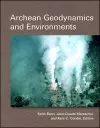
Archean Geodynamics and Environments
3 contributors - Hardback
£84.95
Claude Jaupart graduated from the École des Mines de Paris before obtaining a PhD in geophysics from the Massachusetts Institute of Technology and a doctorat d'Etat from the Université de Paris 7. He has been associated with the Université de Paris 7 and the Institut de Physique du Globe since 1982, serving as director of the IPG between 1999 and 2004, and serving currently as Professor of Geophysics. Professor Jaupart's research covers diverse aspects of the physics of energy transport in the Earth including volcanic and magmatic systems, continental heat flux, and mantle convection. His approach is based on a combination of laboratory experiments in fluid mechanics, field observations, and theoretical studies. His contributions have been acknowledged by many distinctions: the Wager prize from the International Association of Volcanology and Chemistry of the Earth's Interior (1993), the silver medal from the CNRS (1995), the Holweck and the Mergier-Bourdeix prizes from the Academie des Sciences (1995, 1998), the Prestwich medal from the Geological Society of London (1999), the Holmes medal from the European Geophysical Union (2007) and the Harry H. Hess Medal from the American Geophysical Union (2015). Jean-Claude Mareschal holds degrees in theoretical physics from the Université Libre de Bruxelles, applied geophysics from the Université Pierre et Marie Curie, Paris, and geophysics from Texas A&M University. Following positions at the University of Toronto and Georgia Tech he joined the Université du Québec à Montréal in Canada in 1985, where he is now Professor of Geophysics and teaches geophysics and the physics of the Earth. He was also formerly Director of GEOTOP - the Quebec inter-university network for advanced studies and research in geoscience. Professor Mareschal's research interests include the energy budget and thermal regime of the Earth's lithosphere, the mechanical properties of the continental lithosphere in relation to its formation and evolution, and studies of heat flow at the base of ice sheets to detect signs of climate change. Both authors have worked together on the thermal structure and evolution of cratons and have been mapping the heat flow field of Canada for more than twenty years.